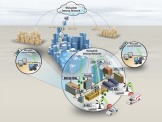 This is a guest post by Sean Sweeney. Sean is the Public Safety Communications Specialist for Telecom Communications and will be writing periodically about issues pertaining to the Public Safety market, in particular the Fire Market.
This is a guest post by Sean Sweeney. Sean is the Public Safety Communications Specialist for Telecom Communications and will be writing periodically about issues pertaining to the Public Safety market, in particular the Fire Market.
Hello, my name is Sean Sweeney and I just started with Telecom Communications, Inc. Previously, I have worked for the City of New York working on Citywide Interoperability projects and coordinated with many agencies. I have also worked on local projects in my home fire department in Central Islip, Long Island.
A lot of first responders I talk to think that communications in the city are very different than out here on Long Island. They think that systems and processes are too complex to be used in Nassau and Suffolk. To an extent they are right. But what is communications and how does it impact the field of public safety?
Communication is the process of transferring information from the source to the recipient. That never changes. But it's how we communicate with each other that define our roles in emergency response. It is likely you have heard the terms interoperability and narrowbanding thrown around. Some first responders fear these concepts simply because they don't understand them.
Interoperability is just a fancy way of saying "I can talk to you, and you can talk to me." You don't realize it, but think about it. You already have interoperability in your agency. You have a radio; your dispatcher has a radio. You can communicate. We all know this is crucial in our daily lives as we respond to fires and EMS calls. But we need to take this concept to the next level.
That next level is stepping back and evaluating your response area. Do you have coverage in every inch of your district? If so, you are in a great position. Now take another step back. Look at the separation between EMS and Fire. Many areas on Long Island run separate agencies. Those departments that surround you and give you mutual aid: can you communicate with them? Can they communicate with you? This is where first responders should start thinking about interoperability.
The explosion of UHF or "high-band" repeater systems in the area has given rise to a sense of isolationism. Departments moved off of crowded, shared low band frequencies and put up their own systems. This was not a bad move but, how do you talk between these bands? I will use the EMS/Fire example. EMS around me uses VHF, but many of the fire departments are on UHF. This is turn causes a communications gap. Technology has given us the tools as first responders to bridge that gap. New multi-band radios (such as the APX7500) allow the first responder to operate on either band with the turn of a knob. A Fire Chief can help direct incoming EMS units at a heavy rescue call. EMT's can notify the fire dispatcher of their status.
Interoperability plays a big role in larger incidents as well. The Federal government has established national interoperability channels for all public safety entities. No additional license is needed, and is available on VHF, UHF, 7/8/900 MHz and more on the way. It is the true path enhancing our abilities as emergency personnel.
Now for narrowbanding. This is actually a result of the UHF explosion. There are only so many frequencies in the public safety pool. The F.C.C. saw this and acted. Previously, frequencies were spaced at 25 kHz. Many departments are still operating with this spacing. As of January 1, 2011, no new licenses or requests for renewals will be accepted by the F.C.C. if you are still operating in wideband mode. Pretty soon (January 1, 2013) it will be illegal to operate equipment not capable of narrowband, or 12.5 kHz operation. Motorola has actually stopped making the older wideband only radios. Here are some important issues from the F.C.C. on Narrowbanding:
-
F.C.C. establishes January 1, 2013 deadline for migration to 12.5 kHz technology
-
The order affects systems on VHF and UHF (high-band) channels between 150 and 512 MHz
-
Applications for wideband operations (25 KHz) will NOT be accepted after January 1, 2011
-
Application modification of operations that expand the authorized contour of an existing station using 25 KHz channels will NOT be accepted after January 1, 2011 (Also applies to "new" systems submitted for licensing)
If you are not sure if your equipment is compliant, give us a call at Telecom. We can evaluate your communications needs and assist you in this transition. Do not wait until the last minute, or you will find yourself without the ability to communicate.



 This is a guest post by Sean Sweeney. Sean is the Public Safety Communications Specialist for Telecom Communications and will be writing periodically about issues pertaining to the Public Safety market, in particular the Fire Market.
This is a guest post by Sean Sweeney. Sean is the Public Safety Communications Specialist for Telecom Communications and will be writing periodically about issues pertaining to the Public Safety market, in particular the Fire Market.